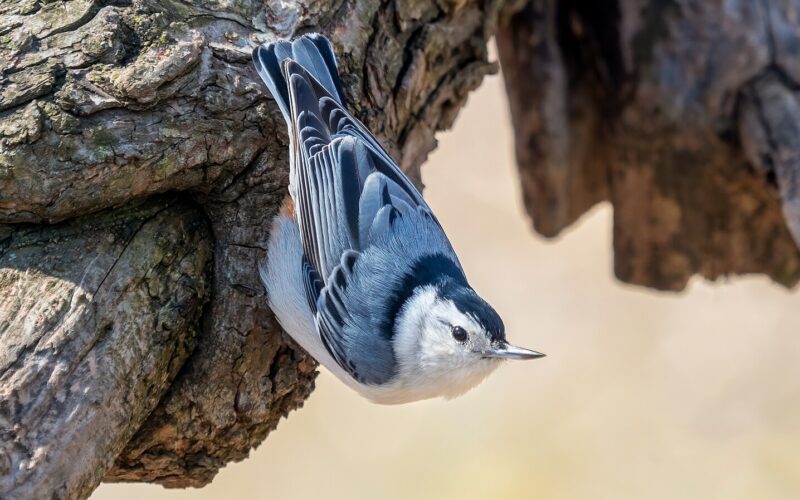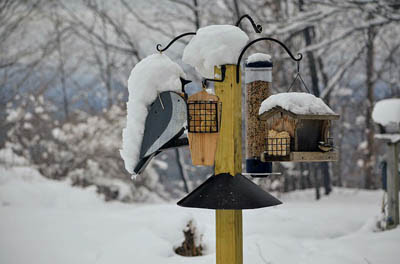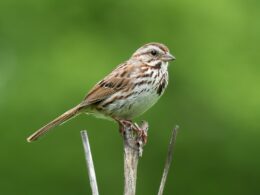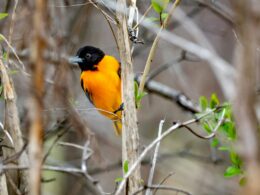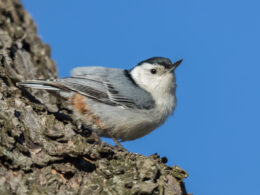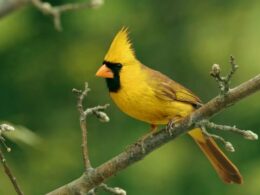Last Updated on January 20, 2024 by Greg Gillson
Welcome to the wonderful world of feeding backyard birds!
If you’ve decided to start feed birds this winter, this post is for you.
Perhaps you’ve already tried feeding birds but have some questions, or are looking for additional ideas. This article is for you, as well.
Finally, perhaps you have been feeding birds in winter for a while. Then you saw this interesting plumage or behavior, and began to wonder. What kind of bird is that? Is it unusual? Or is it a common bird I’ve just never noticed before?
This article tells why and how to set up a bird feeder in Massachusetts in the winter. I’ll also show you photos of the common feeder birds in Massachusetts that you can look for at your own backyard feeder! I will give brief identification tips. I will tell you what foods and what type of feeders attract each species.
The northern position of Massachusetts lead to quite cold winters. Winters are frosty when clear, wet, icy, or snowy otherwise.
Cape Cod receives about 25 inches of snow annually. In the western mountains, 80 inches of snowfall is the seasonal average.
This cold and frequently snowy weather means that hungry birds will be flocking to your feeder in Massachusetts in winter.
Why feed winter birds in Massachusetts?
Winter is the best time to get close looks at your backyard birds. Because winters are cold in Massachusetts, many birds come quickly and easily to bird feeders. They soon become quite fearless.
In summer these birds may flee as soon as you open your door. But now, in winter, they may only move to a nearby bush to watch as you refill the feeder. Some may remain just out of reach, waiting for you to finish.
Additionally, the leaves are off the deciduous trees and bushes. If there is snow on the ground, they have fewer places to hide. They are obvious and easy to see. If you carefully place your bird feeder to be visible from inside your house, you’ll have a great view!
The antics and activity at bird feeders can provide hours of enjoyment. Watching how wild birds behave is entertaining and enlightening. You’ll soon note a pecking order between and among species. You may note a particular time when you can expect a certain species, or even an individual bird.
Watching birds at feeders can bring you closer to nature. That’s something we all need–especially children. If you can share your birds with young people, what a great benefit. And it can bring the family together in a shared activity.
Feeding birds in winter is a perfect home schooling project. Or, it can provide an activity during the winter school break. That’s how I got started… 48 years ago!
Most birds that come to our feeders in winter don’t actually need us to survive. But our feeder foods sure make it easier!
There are generally more individual birds in towns. Towns create warmer microclimates, and the landscaping may provide additional roosting places for birds over the open countryside. That’s for the kind of birds that come to feeders. Towns may be scorned by other types of local birds.
Thus, there may be more birds in towns than the residential habitat can feed naturally. So bird feeders may increase the number of backyard birds that the habitat would be able to support without us feeding them.
What birds come to feeders in winter in Massachusetts?
Most people offer bird seeds at their bird feeders. Thus, it should come as no surprise that most of the birds that come to feeders in winter in Massachusetts are seed eating birds! These are the easiest to attract.
Seed eating birds are most frequent in winter. There are few or no insects or fruits by late winter. Thus, birds that eat these things migrate southward in the fall migration. However, if you have some fruit, many seed-eating and omnivorous birds will eat those.
The northern latitudes and harsher winter weather causes an interesting phenomenon. These two things combine to make it so that most birds at feeders in winter in Massachusetts are year-round residents!
That’s right. The less-hardy birds migrate south for the winter. And some birds that breed north in Canada, migrate south, past Massachusetts. There are some northern birds that come south to Massachusetts in winter, but these aren’t as numerous, and generally aren’t backyard bird feeder birds.
If you learn the winter feeder birds below, you’ll have a good start on some many of the common summer birds in Massachusetts, as well! Of course, these don’t include the summer birds that feed primarily on insects or fruits and berries.
If you want to learn more about the birds that live in your backyard all through the year, not just the winter, then you should read my article Common backyard birds in Massachusetts. I’ll link to this again at the end of this article so you can read it.
How many of the following species have you identified at your bird feeders? Have you seen others? Many are possible.
 |
| Black-capped Chickadee. Greg Gillson. |
Black-capped Chickadee
This cute little ball of fluff, combined with its seeming lack of timidity at the feeder, has endeared it to many.
These bird are found in deciduous and mixed woods. They are common across Alaska, Canada, and the northern United States.
Black-capped Chickadees are year-round residents throughout Massachusetts.
They have small round bodies and a large head. The bill is short and stout. The active tail is rather long with a round tip. The legs and feet are strong. The wings are short and rounded.
The most obvious mark is the black crown and wide bib, set off with the white side of the face. The rest of the upper parts are gray. The underparts are pale, with extensive buff on the flanks and sides.
Black-capped Chickadees love black oil sunflower seeds from tube feeders. They also eat suet.
 |
| Blue Jay. Skeeze from Pixabay. |
Blue Jay
Often noisy and aggressive, people either love or hate this colorful character.
These birds live in deciduous woodlands and parks, especially those with oak trees. They are found east of the Rocky Mountains from southern Canada throughout the Eastern United States.
Blue Jays are permanent residents throughout Massachusetts.
These birds have rather stout bodies and long tail. The obvious mark for this species is the crested head. Legs and feet are strong. The bill is fairly long and stout.
These birds are blue above and pale gray or white below. They have a white face and blue crest. They have a black necklace that wraps up over the back of the head. The wings and tail are barred with black and white flecks and patches.
Blue Jays love peanuts and other nuts from platform feeders. They also love suet. They will eat sunflower seeds, too.
 |
| Northern Cardinal. Tlparadis from Pixabay. |
Northern Cardinal
This bright bird with the perky crest is a winter time favorite at the bird feeder.
These birds like deciduous woodlands and towns. They are found throughout the eastern United States and South. There is also a population in the desert Southwest!
Northern Cardinals are year-round residents in Massachusetts.
These are rather plump birds with long rounded tails. They have a huge bill and crest which gives them a large-headed look.
Males are bright scarlet with a black face. Females are pale brown with some red hints.
Northern Cardinals eat a wide variety of seeds including sunflower seeds and safflower seeds from platform feeders or on the ground.
 |
| Dark-eyed Junco. Greg Gillson. |
Dark-eyed Junco
These small “snowbirds” feed in flocks, flashing white tail feathers as they fly away.
These birds breed in forests across Alaska and Canada and the mountains of eastern and western United States. In winter they move southward and lower in elevation, to be found in open areas throughout the US.
Dark-eyed Juncos breed in the western mountains of Massachusetts and winter throughout the state.
These are small plump birds with square ended tail. They have large heads on short necks. The bills are small and conical.
The juncos in the East are rather dark gray throughout, white on the belly. The outer tail feathers are white and obvious in flight. Females tend to show more brown on the back and wings.
Dark-eyed Juncos eat millet on the ground or platform feeders.
 |
| Tufted Titmouse. Anne773 from Pixabay. |
Tufted Titmouse
This drab bird is slightly larger than a chickadee. It has a crest that it can raise and lower, but isn’t always very obvious.
These birds live in woods year-round in the eastern United States.
Tufted Titmouses are residents throughout Massachusetts.
These birds are stocky with a wide tail and large head. The feed and legs are strong. The bill is short and stout. A wispy crest can be raised and lowered.
The upper parts of these birds are dark gray. The under parts are pale with a peachy cast on the flanks. The forehead has black feathers.
Tufted Titmouses eat mixed seeds and nuts from hopper feeders.
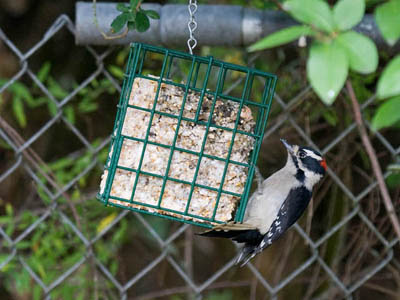 |
| Downy Woodpecker. Greg Gillson. |
Downy Woodpecker
North America’s smallest woodpecker is frequently found at bird feeders in winter.
These birds are found in deciduous woods and river edges, especially willows. They do not migrate, but are found all through the year from Alaska, across Canada, and all the United States except the deserts of the Southwest.
Downy Woodpeckers live year-round throughout Massachusetts.
These birds are stocky with large heads and very short pointed tails. The legs are short and the feet large and strong.
These woodpeckers are black above and white below with black-and-white striped heads, white back, white outer tail feathers. Males have a small patch of red feathers on the back of the head.
Downy Woodpeckers love suet at backyard bird feeders.
 |
| White-breasted Nuthatch. Greg Gillson. |
White-breasted Nuthatch
These active birds crawl up, over, and around tree limbs and trunks–even upside-down!
These birds are found throughout the year primarily in deciduous woods in the East, oaks and dry pine forests in the West.
White-breasted Nuthatches are found year-round throughout Massachusetts.
Nuthatches are stocky with big heads and stubby tails. The bill is rather long and sharp pointed. The legs and feet are strong.
Blue gray on the back and wings. A black stripe goes over the top of the head. The face and under parts are white, with a rusty wash on the lower belly and vent.
White-breasted Nuthatches eat black oil sunflower seeds and peanuts from hopper and tube feeders. They also love suet.
 |
| Mourning Dove. Greg Gillson. |
Mourning Dove
This is one of the most widespread birds of the United States. You no doubt have heard their mournful cooing on summer mornings.
These birds live in farms and towns and river woodlands across the US. Birds leave southern Canada and the northern Great Plains in winter.
Mourning Doves live year-round throughout Massachusetts.
These are plump-breasted birds with small round heads. The tail is long and very pointed. Legs are short.
The general color of these doves is tan or fawn, with a slight pinkish cast on the chest. The sides of the tail are tipped with white feathers. There are black spots on the wings.
Mourning Doves eat a wide variety of seeds and grains, including sunflower seeds and cracked corn, from platform feeders or the ground.
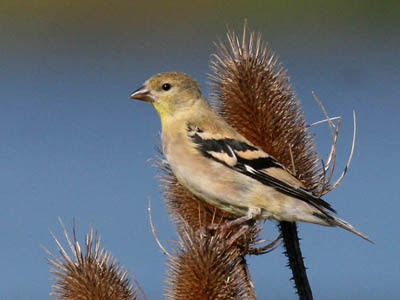 |
| American Goldfinch. Greg Gillson. |
American Goldfinch
This bright lemon yellow and black summer favorite “wild canary” is not as easily identified in its drab winter plumage.
These birds like weedy fields with scattered saplings. They breed from southern Canada to mid-latitudes of the United States, from coast-to-coast. In winter birds leave Canada and are found all the way to the southern US.
American Goldfinches are year-round residents throughout Massachusetts.
These are very small finches. They have long bodies, small round head, short forked tail.
In winter, these birds are pale tan with yellow on the throat. The black wings have broad pale wing bars.
American Goldfinches love Niger seed at thistle feeders. They also eat black oil sunflower seeds from tube feeders.
 |
| Song Sparrow. Greg Gillson. |
Song Sparrow
This brush-loving bird also shows up in large bushes in town. They spend much of their time feeding on the ground.
These birds are found in brushy tangles and cattails. Birds that breed in Canada and the northern United States in summer, migrate south to the southern United States in winter.
Song Sparrows live throughout the year in Massachusetts.
These are plump birds with longer rounded tails and a round head.
These birds are streaked above with light and dark brown streaks on a gray plumage. Underneath, they have dense dark breast streaks on white underparts. These streaks converge into a large spot on the upper breast. The head is gray with brown lateral crown stripes, a line back from the eye, a thin mustache stripe and wide lateral throat stripe.
Song Sparrows eat mixed seeds from low platform feeders or from the ground.
 |
| House Sparrow. Greg Gillson. |
House Sparrow
This well-named bird is common in towns and cities.
Can a dumpster in a fast-food parking lot be habitat? These birds thrive in cities, residential areas, and farms. These birds are residents across Canada, the United States, and Mexico, wherever there are groups of people.
House Sparrows are year-round residents throughout Massachusetts.
These are smaller plump birds with big flat heads. Their tails are medium-short.
Males are gray and chestnut above, gray below. The head of males features a gray crown and black bib that varies in extent by season. Females are rather a dingy brown, paler below, with a pale eyebrow line. These birds have dingy, but unstreaked breasts that help separate them from the streaked house finches.
House Sparrows eat small seeds from platform and hopper feeders. They are one of the few birds that eat red milo, an ingredient in cheap bird seed. They also eat human food scraps.
Setting up a winter bird feeding station in Massachusetts
A tube feeder with black oil sunflower seeds is first on my list of recommended bird feeders for winter birds in Massachusetts. The linear shape of these hanging tube feeders means that they won’t get covered by snow.
Such a tube feeder will attract Black-capped Chickadees, American Goldfinches, and White-breasted Nuthatches. Tube feeders will keep out the House Sparrows and Blue Jays.
Next, a hopper feeder filled with mixed seeds will do well. There is one particular kind of mixed seed I highly recommend. It is 50% sunflower seeds and zero cheap filler (learn what it is and read my review here). Birds love it!
The mixed seed will attract Tufted Titmouses, Song Sparrows, Black-capped Chickadees, Northern Cardinals, White-breasted Nuthatches, Mourning Doves, and Dark-eyed Juncos.
Finally, I recommend a suet feeder. (Read my article on suet feeders.) A simple suet cage will work. If jays, grackles, and starlings are a problem–eating your suet in 10 minutes–then an upside down suet feeder works great.
Birds that eat suet include Blue Jays, White-breasted Nuthatches, Downy Woodpeckers, Black-capped Chickadees, and Tufted Titmouses.
A combination of these bird feeders and foods will bring a wide variety of birds to your backyards this winter. Enjoy!
Wrapping Up
Cape Cod is the jewel of Massachusetts birding and even in winter there is some great birding to be had. Here are my picks of birds to be found on this incredible coastline.
Seabirds and Waterfowl:
- Loons: Common Loons and Red-throated Loons grace the coast with their haunting calls and graceful dives.
- Ducks: A variety of ducks like American Black Ducks, Common Eiders, and Long-tailed Ducks flock to bays and salt marshes.
- Geese: Canada Geese and Brant Geese gather in large groups, adding honking melodies to the winter landscape.
- Gulls: Iceland Gulls, Glaucous Gulls, and Lesser Black-backed Gulls add variety to the coastal scene with their impressive wingspans and distinctive calls.
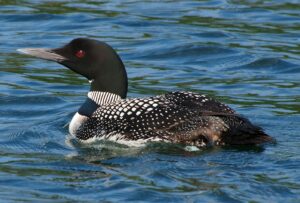
Shorebirds:
- Black-bellied Plovers: These dapper shorebirds, with their black belly patches and contrasting white chests, strut along the beaches.
- Purple Sandpipers: These hardy birds forage among rocks and seaweed, adding splashes of purple to the rocky coastline.
- Dunlins: Large flocks of these small sandpipers flit along the shoreline, creating a mesmerizing spectacle.
Land Birds:
- Songbirds: American Robins, White-throated Sparrows, Dark-eyed Juncos, and Yellow-bellied Sapsuckers add color and song to woodlands and shrublands.
- Raptors: Northern Harriers, Rough-legged Hawks, and Red-tailed Hawks soar above the fields, scanning for prey.
- Owls: Great Horned Owls, Eastern Screech-Owls, and Barred Owls keep watch from trees, adding a touch of mystery to the nighttime landscape.
Frequently Asked Questions
What are the finches in the winter in New England?
Winter in Massachusetts offers a fascinating array of finches, both resident and visitors, bringing splashes of color and chirpy music to the snowy landscapes. Here are some of the common finches you can encounter:
Resident Finches:
- American Goldfinch: These iconic songbirds, despite their drab winter plumage compared to summer’s bright yellow, remain common visitors to feeders and open fields, feasting on sunflower seeds and thistle.
- House Finch: These cheerful brown and streaked finches readily visit feeders and add lively chirps to your backyard, even throughout winter.
- Pine Siskin: These small, olive-brown finches with yellow wing bars flock to coniferous forests, feasting on pine seeds and occasionally visiting feeders.
- Common Redpoll: These tiny, streaked finches with red caps (males) or pinkish heads (females) form nomadic flocks, searching for seeds in fields and along roadsides.
Winter Visitors:
- Evening Grosbeak: These large, chunky finches with vibrant yellow bodies and black wings add a splash of color to coniferous forests, attracted to pine seeds during winter irruptions.
- Pine Grosbeak: These larger cousins of the evening grosbeak, with their rosy chests and thick bills, can occasionally be found in northern Massachusetts during irruptions, feasting on berries and conifer seeds.
- Red Crossbill: These specialized finches with crossed mandibles adapted for extracting seeds from pine cones might visit coniferous forests in small groups during winter irruptions.
What does a winter goldfinch look like?
Unlike their vibrant yellow attire in summer, American Goldfinches undergo a dramatic wardrobe change for winter, adopting a much more subdued look. Here’s what these captivating songbirds wear during the colder months:
Overall Tone: The winter plumage leans towards a dull yellow or olive-brown, lacking the striking bright yellow of summer. Some individuals might even appear more brown than yellow.
Head and Neck: The black cap, characteristic of both breeding and non-breeding seasons, remains prominent. However, the black area might extend further down the throat compared to summer.
Body: The yellow feathers are streaked with brown, creating a mottled appearance. This camouflage pattern helps them blend in with winter landscapes and potentially avoid predators.
Wings: The black wings with white wing bars remain a constant feature, providing a distinctive contrast against the muted body colors. This wing pattern is helpful for identification even in winter plumage.
Bill: The orange bill of summer dulls to a pale yellow or brownish-yellow in winter.
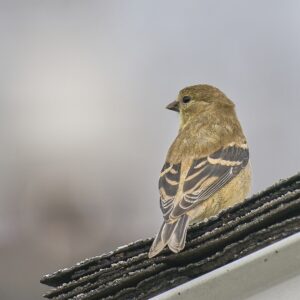
What is the most common bird in Massachusetts?
The Black-capped Chickadee is the most commonly reported bird in Massachusetts. This energetic little songbird thrives in forests and wooded areas throughout Massachusetts. Their inquisitive nature, acrobatic foraging skills, and distinctive “chick-a-dee-dee” calls make them easily encountered and widely recognized. They are the official state bird of Massachusetts, further solidifying their common status.
Related Articles:
The most common backyard birds in Massachusetts
My recommended bird feeder setup
Bird seeds that attract the most birds
Different kinds of bird feeders for different birds
Bird baths that birds actually use






